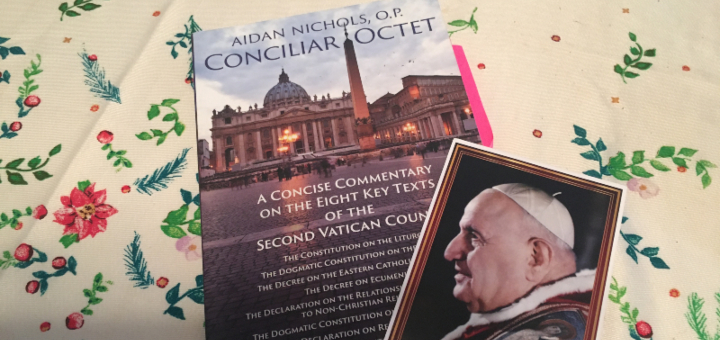
 I was born in 1970 and grew up Catholic in a world where the Latin Mass wasn’t said at all. The Church had already gone through the upheaval of changes that the Second Vatican Council brought about. I never saw an altar rail at Mass, we had a guitar Mass, and when I made my First Holy Communion on my eighth birthday, I did so in the hand. (We were the first class allowed to do this at my parish, and Sister told us that it was only just approved for us to do so.)
We did have a few traditions that I learned later were leftover from what we now call the Extraordinary Form: bells at the Consecration and people crossing themselves after the Kyrie. I remember distinctly when our parish took those bells away (and I always felt like that about it), and it was explained that those were for when people didn’t know what was happening at Mass, so they could look up at the right time.
But I never experienced any of that myself.
When I had a reversion to the Faith as an adult, I ran across people who believed that the Catholic Church today is not the true Church. As someone who was learning about many of our older traditions and delving deeper into my faith, I was shaken to think that perhaps I’d been led astray by a fake church that had broken from Tradition after the Second Vatican Council. But a kind woman in an online forum talked me down, reminding me that the Holy Spirit either guides the Church or He doesn’t. And if He does, then Vatican II was not a terrible split from the Traditions of the Church but a continuation of our understanding of how God works in the world through His Church.
I have had a desire to learn more about Vatican II, but admit to being a little lazy about it. There’s so much information, so many documents, and I felt overwhelmed thinking about where I ought to start. So when I had the opportunity to review a new book from Ignatius Press covering the eight key texts from the Second Vatican Council, I jumped on it.
I was born in 1970 and grew up Catholic in a world where the Latin Mass wasn’t said at all. The Church had already gone through the upheaval of changes that the Second Vatican Council brought about. I never saw an altar rail at Mass, we had a guitar Mass, and when I made my First Holy Communion on my eighth birthday, I did so in the hand. (We were the first class allowed to do this at my parish, and Sister told us that it was only just approved for us to do so.)
We did have a few traditions that I learned later were leftover from what we now call the Extraordinary Form: bells at the Consecration and people crossing themselves after the Kyrie. I remember distinctly when our parish took those bells away (and I always felt like that about it), and it was explained that those were for when people didn’t know what was happening at Mass, so they could look up at the right time.
But I never experienced any of that myself.
When I had a reversion to the Faith as an adult, I ran across people who believed that the Catholic Church today is not the true Church. As someone who was learning about many of our older traditions and delving deeper into my faith, I was shaken to think that perhaps I’d been led astray by a fake church that had broken from Tradition after the Second Vatican Council. But a kind woman in an online forum talked me down, reminding me that the Holy Spirit either guides the Church or He doesn’t. And if He does, then Vatican II was not a terrible split from the Traditions of the Church but a continuation of our understanding of how God works in the world through His Church.
I have had a desire to learn more about Vatican II, but admit to being a little lazy about it. There’s so much information, so many documents, and I felt overwhelmed thinking about where I ought to start. So when I had the opportunity to review a new book from Ignatius Press covering the eight key texts from the Second Vatican Council, I jumped on it.
 Copyright 2020 Christine Johnson. All rights reserved.[/caption]
Of course, it helps that it was written by a Dominican friar: Aidan Nichols, O.P. As someone who is a Lay Dominican, I have a love for all things Dominican. Fr. Nichols’ book, Conciliar Octet: A Concise Commentary on the Eight Key Texts of the Second Vatican Council, looks carefully at the following texts and the history of each one’s development:
Copyright 2020 Christine Johnson. All rights reserved.[/caption]
Of course, it helps that it was written by a Dominican friar: Aidan Nichols, O.P. As someone who is a Lay Dominican, I have a love for all things Dominican. Fr. Nichols’ book, Conciliar Octet: A Concise Commentary on the Eight Key Texts of the Second Vatican Council, looks carefully at the following texts and the history of each one’s development:
- The Constitution on the Liturgy
- The Dogmatic Constitution on the Church
- The Decree on the Eastern Catholic Churches
- The Decree on Ecumenism
- The Declaration on the Relationship of the Church to Non-Christian Religions
- The Dogmatic Constitution on Divine Revelation
- The Declaration on Religious Liberty
- The Pastoral Constitution on the Church in the Modern World
The future Cardinal Walter Kasper settled on a total of four rules of thumb: integral understanding of the text, rather than picking and choosing; the unity of their “letter” and their “spirit,” to be “discovered by pursuing the textual history in detail and from this extracting the council’s intention”; the uninterrupted Tradition of the Church (but, as Lanzetta remarks, this should be the superordinate criterion, not one of the subordinate criteria), and, lastly — here Kasper ventures a formulation that is open to abuse — “a unity between tradition and a living, relevant interpretation in the light of the current situation.” (p.16)Fr. Nichols delves into each document with the intent to demonstrate how the major documents of Vatican 2 came about, as well as how they are legitimate developments of doctrine and disciplines of the Church. For anyone who wants to better understand what exactly happened almost 60 years ago at the Second Vatican Council, Conciliar Octet is a must-read.

Visit our Book Notes archive.
Copyright 2020 Christine Johnson
About the Author

Christine Johnson
Christine Johnson has been married to Nathan since 1993 and is the mother of two homeschool graduates. She and Nathan live in the Blue Ridge Mountains of Southwest Virginia, where she tries to fit in as a transplanted Yank. She blogs at Domestic Vocation about her life as a wife, mother, and Lay Dominican.


.png?width=1806&height=731&name=CatholicMom_hcfm_logo1_pos_871c_2728c%20(002).png)
Comments